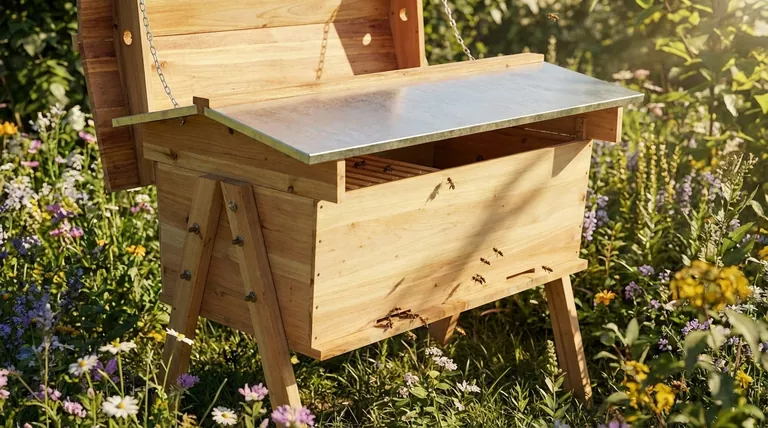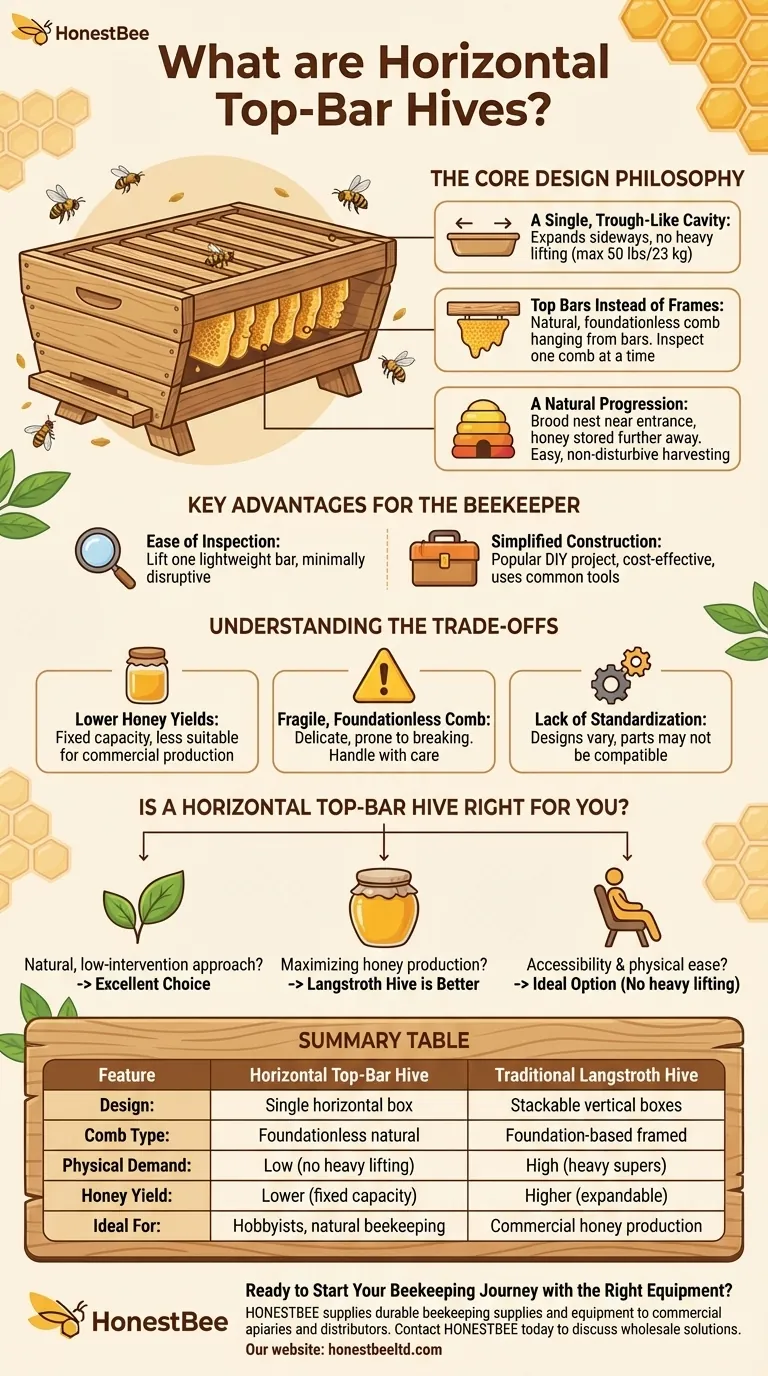In essence, a Horizontal Top-Bar Hive (HTBH) is a single-story, trough-shaped beehive where bees build their honeycomb hanging from removable bars placed across the top. Unlike conventional hives that use complex boxes and frames, the top-bar design prioritizes simplicity and a more natural, foundationless comb, making it exceptionally easy for beekeepers to manage and inspect.
The core principle behind the Horizontal Top-Bar Hive is to simplify beekeeping by eliminating heavy lifting and complex equipment. It exchanges maximum honey production for superior ease of use and a less intrusive experience for both the bees and the beekeeper.

The Core Design Philosophy
A Horizontal Top-Bar Hive operates on a few simple, yet powerful, principles that distinguish it from the more common multi-box Langstroth hive.
A Single, Trough-Like Cavity
The entire hive is contained within one long, protected box. This horizontal layout means the colony expands sideways rather than vertically.
This design completely eliminates the need for lifting heavy boxes (supers) full of honey, which can often weigh over 50 pounds (23 kg).
Top Bars Instead of Frames
The defining feature is the set of simple wooden bars that rest across the top of the hive body. Each bar is carefully measured to provide the correct bee space.
Bees naturally build one comb hanging down from each individual bar. The beekeeper can lift any single bar to inspect the comb without disturbing the rest of the nest.
A Natural Progression
The bees organize the hive logically along its length. They typically establish the brood nest (where the queen lays eggs) near the entrance and store honey and pollen in the combs further away.
This predictable layout allows the beekeeper to easily locate and harvest honey from the back of the hive while leaving the crucial brood nest undisturbed at the front.
Key Advantages for the Beekeeper
The design choices of the Horizontal Top-Bar Hive translate directly into several significant benefits, especially for hobbyist or backyard beekeepers.
Ease of Inspection
Inspecting the colony is straightforward and minimally disruptive. You only need to lift one bar at a time, which is lightweight and easy to handle.
This "one comb at a time" approach is far less stressful for the bees and less physically demanding for the person managing the hive.
Simplified and Flexible Construction
The hive's simple geometry makes it a popular DIY project. Its basic design can be built with common woodworking tools and materials, offering significant flexibility.
This inherent simplicity makes it one of the most cost-effective ways to begin beekeeping.
Understanding the Trade-offs
While simple and easy to manage, the Horizontal Top-Bar Hive is not the ideal solution for every goal. Its design comes with inherent limitations.
Lower Honey Yields
The single, fixed-size cavity limits the total space available for honey storage. Unlike stackable hives that can be expanded indefinitely, an HTBH has a finite capacity.
This makes it less suitable for beekeepers whose primary goal is commercial-scale or maximum honey production.
Fragile, Foundationless Comb
The comb is only attached to the top bar, not supported by a four-sided frame. This makes it more delicate and prone to breaking, especially during inspections.
Beekeepers must handle the combs with care, always keeping them in a vertical position to avoid catastrophic detachment.
Lack of Standardization
Unlike the globally standardized Langstroth hive, top-bar hive designs can vary. This means parts from one hive may not be compatible with another, making it harder to source replacements or interchangeable equipment.
Is a Horizontal Top-Bar Hive Right for You?
Choosing a hive style depends entirely on your personal beekeeping goals. The HTBH excels in specific scenarios but is less optimal in others.
- If your primary focus is a natural, low-intervention approach: The HTBH is an excellent choice, as it encourages bees' natural comb-building and requires less disruptive management.
- If your primary focus is maximizing honey production: A modular, stackable hive like the Langstroth is a more effective tool for achieving high yields.
- If your primary focus is accessibility and physical ease: The no-heavy-lifting design of the HTBH makes it the ideal option for beekeepers with back problems or limited strength.
Ultimately, this hive design represents a philosophy that places the beekeeper's experience and the bees' natural behavior at the forefront.
Summary Table:
| Feature | Horizontal Top-Bar Hive | Traditional Langstroth Hive |
|---|---|---|
| Design | Single, horizontal box | Stackable, vertical boxes |
| Comb Type | Foundationless, natural comb | Foundation-based, framed comb |
| Physical Demand | Low (no heavy lifting) | High (heavy supers) |
| Honey Yield | Lower (fixed capacity) | Higher (expandable) |
| Ideal For | Hobbyists, natural beekeeping | Commercial honey production |
Ready to Start Your Beekeeping Journey with the Right Equipment?
Whether you're a hobbyist drawn to the simplicity of a top-bar hive or a commercial apiary focused on high-yield production, having reliable, high-quality equipment is fundamental to your success.
HONESTBEE supplies durable beekeeping supplies and equipment to commercial apiaries and beekeeping equipment distributors through our wholesale-focused operations. We provide the foundational tools you need to manage your colonies effectively and sustainably.
Contact HONESTBEE today to discuss your equipment needs and learn how our wholesale solutions can support your beekeeping goals.
Visual Guide

Related Products
- Long Langstroth Style Horizontal Top Bar Hive for Wholesale
- HONESTBEE Professional Long Handled Hive Tool with Precision Cutting Blade
- Top Bar Beehive for Beekeeping Wholesales Kenya Top Bar Hive
- HONESTBEE Professional Multi-Functional Hive Tool with Ergonomic Wood Handle
- HONESTBEE Advanced Ergonomic Stainless Steel Hive Tool for Beekeeping
People Also Ask
- What are the benefits of a top bar hive? A Natural, Low-Impact Approach to Beekeeping
- What are the benefits of the top bar hive? A Guide to Ergonomic, Natural Beekeeping
- What is a top bar bee hive? A Natural, Low-Stress Beekeeping Solution
- What are the main differences between Langstroth hives and top bar hives? Choose the Right Hive for Your Beekeeping Goals
- What are the most popular types of hives besides the Langstroth? Top Bar & Horizontal Hives Explained



















